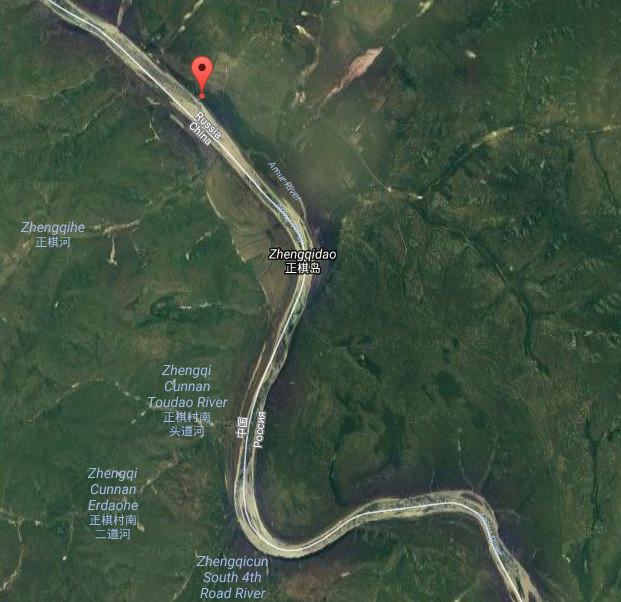This will seem strange, like something out of The Rime of the Ancient Mariner.
 For the past few weeks I’ve been adapting my orbital simulation model to calculate the tidal forces at the surface of the Earth due to Sun and Moon gravitation, as well as the rotation of the Earth. One effect of the rotation of the Earth is that there is a centrifugal force, CF, acting outwards from the Earth’s axis everywhere on its surface. In the northern hemisphere, the sum of this centrifugal force and the Earth’s gravitational force, GF, produces a small resultant force, RF, in a southerly direction in the plane of the Earth’s surface. And this small force, constantly acting on a body on the surface of the Earth, would act to gradually accelerate it southwards across the surface of the Earth.
For the past few weeks I’ve been adapting my orbital simulation model to calculate the tidal forces at the surface of the Earth due to Sun and Moon gravitation, as well as the rotation of the Earth. One effect of the rotation of the Earth is that there is a centrifugal force, CF, acting outwards from the Earth’s axis everywhere on its surface. In the northern hemisphere, the sum of this centrifugal force and the Earth’s gravitational force, GF, produces a small resultant force, RF, in a southerly direction in the plane of the Earth’s surface. And this small force, constantly acting on a body on the surface of the Earth, would act to gradually accelerate it southwards across the surface of the Earth.
That we don’t see things moving southwards the whole time in the northern hemisphere is probably because most things are restrained by strong forces of friction, because the Earth is not a perfectly smooth sphere. But what if there were no frictional resistance? What would we see happening? If we started our journey in the middle of England, where would we end up?
 In my model I simulated this journey with a ball-bearing which was dropped onto the surface of the Earth, and allowed to just keep on frictionlessly bouncing on its surface. My journey started just outside the village of Hurley, northeast of Birmingham, at 52.567ºN, -1.632ºW. As expected, the bouncing ball-bearing gradually began to accelerate southwards.
In my model I simulated this journey with a ball-bearing which was dropped onto the surface of the Earth, and allowed to just keep on frictionlessly bouncing on its surface. My journey started just outside the village of Hurley, northeast of Birmingham, at 52.567ºN, -1.632ºW. As expected, the bouncing ball-bearing gradually began to accelerate southwards.
Fairly soon, it had travelled all the way south over England and out into the English Channel (completely frozen over for this experiment). As it did so, it began to swing surprisingly westwards,  moving in an arc first over Brittany in France, and then towards Galicia in Spain. The blue track in my simulation map (right) shows the curving path. This is the effect of the coriolis force, which acts in the northern hemisphere to turn southward-moving bodies to the right.
moving in an arc first over Brittany in France, and then towards Galicia in Spain. The blue track in my simulation map (right) shows the curving path. This is the effect of the coriolis force, which acts in the northern hemisphere to turn southward-moving bodies to the right.
 By the time we passed over Galicia, in NW Spain, the effect of the coriolis forces acting along the way had shifted the direction of travel strongly towards the south-west.
By the time we passed over Galicia, in NW Spain, the effect of the coriolis forces acting along the way had shifted the direction of travel strongly towards the south-west.
And thence we continued, out over the flat frozen Atlantic ocean, passing just west of Madeira.
 On and on we travelled, until finally we made landfall west of Cayenne, French Guiana, in South America. By now we were almost travelling westwards.
On and on we travelled, until finally we made landfall west of Cayenne, French Guiana, in South America. By now we were almost travelling westwards.
 We continued over the state of Amazonas in Brazil, and finally departed South America on the coast of Peru, a little south of Lima, and headed out over the frozen plains of the South Pacific.
We continued over the state of Amazonas in Brazil, and finally departed South America on the coast of Peru, a little south of Lima, and headed out over the frozen plains of the South Pacific.
And now that we were in the southern hemisphere, both centrifugal and coriolis forces began to operate in the opposite sense that they had in the northern hemisphere, and we began to slow, and to turn southward.
 Finally, at -52.564ºS, -117.732ºW, while heading directly south, we came to a stop, far out in the South Pacific ocean. But this was no place to get off. We had started at 52.567ºN, and now we’d stopped at almost exactly the same southern latitude. And it became clear that the trajectory of the ball-bearing was just like the swing of a pendulum – and now that we had come to a stop in the southern hemisphere, we would next head northward back to the northern hemisphere.
Finally, at -52.564ºS, -117.732ºW, while heading directly south, we came to a stop, far out in the South Pacific ocean. But this was no place to get off. We had started at 52.567ºN, and now we’d stopped at almost exactly the same southern latitude. And it became clear that the trajectory of the ball-bearing was just like the swing of a pendulum – and now that we had come to a stop in the southern hemisphere, we would next head northward back to the northern hemisphere.
 And this is exactly what happened. We began to move northwards. But instead of retracing our journey eastward, we continued moving westward.
And this is exactly what happened. We began to move northwards. But instead of retracing our journey eastward, we continued moving westward.
Moving northwest over the Pacific, we passed over the atoll of Maupiha’a, in French Polynesia, which was completely deserted aside from a single house.
 And we passed between the deserted atolls of Taka and Utrik in the Marshall Islands.
And we passed between the deserted atolls of Taka and Utrik in the Marshall Islands.
 And when we’d finally completed the crossing of the Pacific, it was a tremendous surprise to pass right over the middle of Tokyo, Japan.
And when we’d finally completed the crossing of the Pacific, it was a tremendous surprise to pass right over the middle of Tokyo, Japan.
And thereafter we passed right over Japan and out across the sea of Japan, making landfall on the Asian continent just east of Vladivostok.
By now we were beginning to slow and swing northwards. For a while it looked like we would come to a halt somewhere in the wilds of Mongolia, and be arrested by Chinese police. But instead we just managed to limp across the Amur river, which divides Russia from China, and landed on the northern Russian side, at 52.559ºN, 126.167ºE, a mere 150 m from the frozen river, to be arrested there by waiting surly Russian police instead.
The journey had begun on Julian date 2457687.60 ,and ended on Julian date 2457689.24056975. So it had taken exactly 1.64056975 days, or 39.373674 hours. During that time we had travelled from 52.56ºN to 52.56ºS, and back again. And we had traversed 232.2 degrees of longitude. When I checked our speed as we passed over Taka atoll, I found we were doing 400 m/s, or 895 mph.
And all this without any expenditure of fuel energy whatsoever, by simply reducing frictional resistance to zero, and allowing tiny centrifugal and coriolis forces to do the work of accelerating and decelerating bodies. We didn’t even use sails.
If it could have been arranged that the point of departure was also the final destination (and maybe it could be), it would have been possible to consider a low energy (and carbon-neutral!) north-south transit system along these lines, with trains arriving and departing at exact times, and returning a day or two later. The trains would probably need an auxiliary engine of some sort – a 125 cc Lambretta engine would probably suffice.
And that was the strange journey I took today.
I told you it was going to be strange.
I hope it made a tiny bit of sense.
…
Here’s the track through the southern hemisphere:
And here’s the departure from England, and the arrival on the banks of the Amur river.

















As the little ball goes Southward, it goes uphill at a ratio of 1 mile up for every 235 miles toward the Equator.
The Earth is an obloid, not a sphere.
Perhaps, the ball would go uphill South until it stopped and then take a curving route downhill to the North Pole where it would come to rest with all Forces being equal?
Good point. This is a model of the Earth as sphere. I’ve got a correction somewhere in the model that introduces the oblateness of the Earth, which I hardly ever use. But it would probably mean re-writing some of the code.
I suspect that if the ball-bearing could get up enough speed, it would be able to carry over the bulging equator, and continue into the southern hemisphere. If not, then as you say it would roll back towards the North Pole, probably to 52.56 degrees N.
But it wouldn’t stop there. Or rather, after it had stopped, it would then start to roll back to the equator again. The same is true of the original model shown above. Once it had got to the river Amur and stopped, it would have carried on and rolled all the way back to the southern hemisphere
That rise is about 22.5 feet per mile.
No wonder the oceans do not pool at the Equator.
Wikipedia:
The Earth has an equatorial bulge of 42.77 km (26.58 mi): that is, its diameter measured across the equatorial plane (12,756.27 km (7,926.38 mi)) is 42.77 km more than that measured between the poles (12,713.56 km (7,899.84 mi)). An observer standing at sea level on either pole, therefore, is 21.36 km closer to Earth’s centrepoint than if standing at sea level on the equator.
The radius of the Earth is usually given as about 6371 km, so its circumference is 40030 km, or 10007 km from pole to equator. So rise in height from pole to equator is 21.36 km over 10007 km, which is 0.0021 km/km or 2.1 m/km, or 3.43 m/mile or 11.26 feet/mile.
That’s half your figure. Although I wouldn’t put it past myself to have got it wrong.
It may get further from the centre of the Earth, but it’s not going “uphill”. The sum of various forces remains constant, that’s why the theoretical Earth is not a sphere?
Yes the trains might need a small amount of power to get going, but in this low friction environment, they’d need some pretty hefty brakes to stop, so the energy from that can be used
to power a decent electric motor. Certainly not a piston ported 2 stroke without oil injection.
However the closest we may get to this sort of environment is Elon Musk’s Hyperloop. And here’s us farting around with HS2. No train drivers needed!
http://www.pocket-lint.com/news/132405-what-is-elon-musk-s-700mph-hyperloop-the-subsonic-train-explained
>>>>For the past few weeks I’ve been adapting my orbital simulation model to calculate the tidal forces…
I stopped right there, and did not read any more. Saw the pic above with the poles, and was like…”THERE IT IS!!!”
I’ve had some thoughts regarding the changes that I made to the Feynman diagram, (assuming you saw them at whatchacallit forums before the went down…it was over at Roob’s blog as well) and some more thoughts about magnetism and the poles. It’s hard to explain here cause I don’t wanna blog-up your blog, but if the whatchacallit forums ever come back up, I’ll write about it there. Still kinda chewing on it with respect to my “more-inclusive” model version of “the theory of everything” or “unified model”…because I had an interesting variable I thought about this morning with respect to genetic mutations and or changes over time…and this is gonna require some thinkin’ on my part. I think I did find the final missing piece this morning with respect to “strings and stings” (not a typo) and parabolic trajectories with respect to magnetism using tachyons and neutrinos.
Lotta energies that have to be included and accounted for, on ever increasing and decreasing scales to account for celestial movements, and their effects with respect to lunar and solar tides of all kinds. It’s not as simple as “The Van Allen Belt” or solar winds or the Oort Cloud, or even orbital dynamics.
Q: If the Earth/Terra was flat, would a round ball roll on it’s surface? Or slide?
Q: If the Earth/Terra was flat, would a square ball roll on it’s surface? Or slide?
Q: Sound ridiculous?
Q: Where are we?
Food for thought. :-)
Transport systems have to keep stopping, at specific points.
But imagine a big wheel, maybe 300metres, constantly rolling down a straight road. (Or in a very large circle?)
It has carriages hanging inside, which remain horizontal. (Think “London Eye”)
Stand at the roadside til the wheel passes. Climb on. (The bigger the wheel, the longer it stays in contact with the road at your location).
You can get off anywhere, within about 500metres of your destination.
If there were enough wheels on your route, a top lane could be resting on them. Get off the wheel at the top, and travel twice as fast until you are half a circumference from your destination, then descend on the next wheel.
This could work at various scales. The bigger the scale, the faster you travel, but the further between available “stops” for you.
Ideally, you would build a city around it. It’s not gonna work in existing ones. A circular city with a big park in the middle?
Or run it down a motorway, with one very long narrow city? Everyone has a motorway in front of their house, and countryside behind.
How big can it get? (Atmosphere.)
Zaphod.
A bit like the bonde trams in Rio, which often moved slowly enough for people to climb on and off anywhere.
Fascinating!
O/T: I’ve seen reports that there was another big prison riot in the UK yesterday, this time in Birmingham. I was wondering if anyone on that side of the pond has any information that might point to this one also being related to a prison smoking ban.
Official story is they had no hot water! We’ll probably never know the truth unless someone has contact with the prison population via facebook or such.
http://www.standard.co.uk/news/crime/birmingham-prison-riot-investigation-after-prisoners-seize-control-in-worst-uk-jail-violence-for-25-a3422721.html
Doesn’t seem to mention smoking bans as the cause of it. Doesn’t everyone love smoking bans?
Pingback: Reproducing Global Warming | Frank Davis
Pingback: A Polyhedral Global Climate Model | Frank Davis